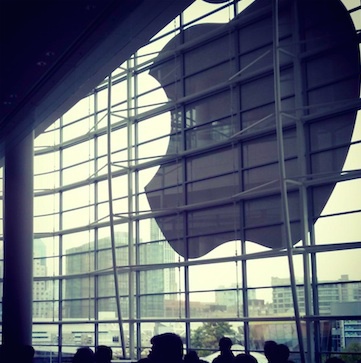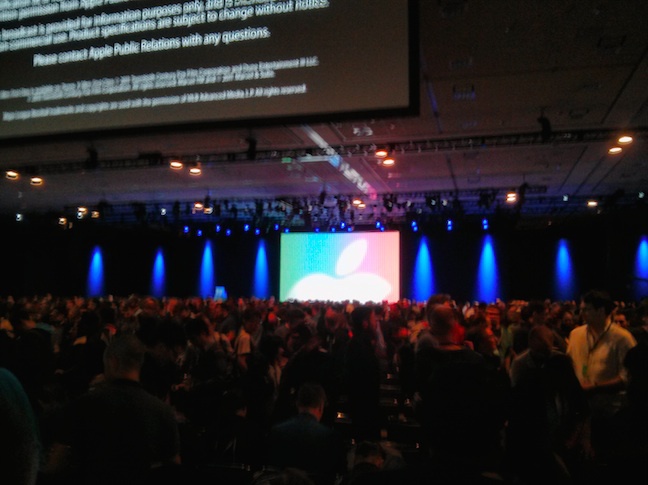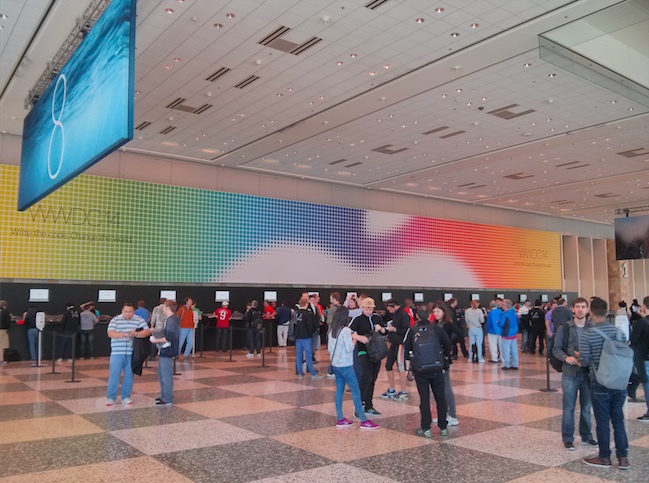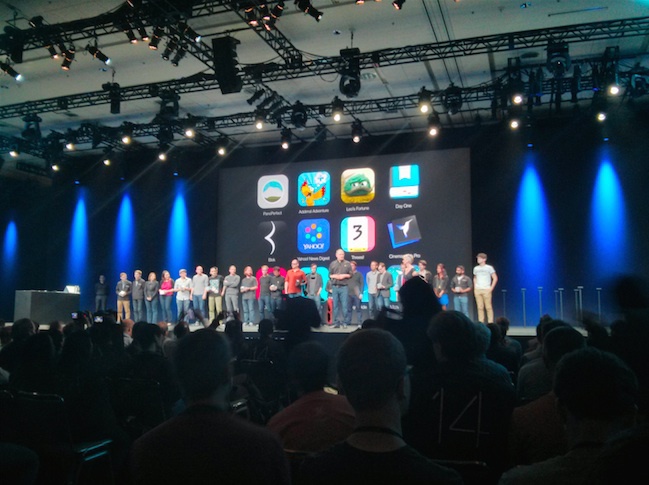WWDC 2014. First impressions of the witness
From San Francisco in sunny California, with the first results of WWDC 2014 - Arthur Sakharov, technical director of Redmadrobot.
A lot of people spent the night in front of Keynote at the Moscone Center on mattresses to be the first to enter the hall. In the queue at the entrance, I saw a dude who was so nervous in anticipation of the show that his hands were already shaking - he did not get into the mouth with a cake. Those who come to the WWDC for the tenth time say that they are invariably committed every year. All developers communicate with each other, this is a real community. And then such a drive - it motivates to develop.

')
The room at Keynote was jam-packed — 6 thousand developers from all over the world clapped at once. The presentation was performed incredibly cool from a technical point of view - it’s not at all clear how some technical solutions were made. Yes, everything is calculated there, all devices are connected to some internal systems for notifications to work, etc. But this is very cool.
Cook, after the presentation, ran backstage, all 6 thousand developers would like to catch it ...
- I can say this - this conference has justified its name. It was a show for developers and Apple prepared all of its solutions for them. No new hardware, just this one - but from the existing devices Apple squeezed the darkness of the functions. The same TouchID - it was re-opened and made available for applications. This is a huge leap.
The first day is over, the developers right now say: “They write on Twitter that developers are disappointed. Bullshit, developers are super excited, gadget freaks are the only ones ones who are disappointed! ”

- Previously, in disputes, they always remembered that iOS sucks, because it does not have a custom keyboard , and Android has a great many. Okay, an elegant solution came out - Apple introduced an external API for such keyboards, all of which work in the internal sandbox - no private data will flow into the network in principle. For sure Swype will be.
The company in general has embroiled all existing hardware simply with the fact that you can make new software for them. That is, part of the functional has finally given into the hands of the developers, rather than developing it itself.
- Apple's new policy - integrate all devices into a single system. From the scene on Keynote, the word continuity sounded many times - this is when you can simultaneously use a Mac, tablet, phone, start the process on one device, end on another. This is cool - developers can immediately do whole agglomerations of applications.
Google is moving in the same direction: it controls Chrome on the computer and Android phones, but Google, apparently, will not have normal integration with the desktop (we will lower Chrome OS). And Apple makes all the devices under one brand, and these devices are synchronously updated (with which Google has problems) and work together.
But up to this point, Mac OS X has never been so integrated with the mobile platform. And now the desktop smoothly flows into the mobile platform and vice versa, it all becomes a single ecosystem.
It confirms my vision that smart watches, etc., wearable devices are no new functionality, but just new features, opportunities that are added to what is already there. Even more features that are shared between devices.
This is similar to where progress as a whole will move - everything will come together into a single ecosystem. What was the idea of an ideal future five or ten years ago? That there will be a strong fast web, and a single portal will appear in the cloud - the user from any device comes in there and gets access to their virtual data. This all goes. The web is not yet so strong, but the platforms penetrate each other altogether.

- iOS 8 . Google what wins? He has a very cool search for applications, and when the user enters the store, he has something to profit from. And in the App Store in the ratings are always top applications that have been there for years - all sorts of games, etc.
Apple realized its flaws and started talking about new search, new cataloging, etc. - the company is trying to stir up the App Store, the figures were announced: 1.2 million apps and 75 billion downloads, and more users joined this year than in all of the past years taken, and these new users go to the app store to see what is there. Therefore, a big goal - to give access to interesting applications. And the main feature is the normal App Store. See if it works out.
- Apple for the first time implements the connection between applications . Previously, in all 7 versions of iOS, the connection between applications was at the level of “there is Facebook, there is Twitter, they agreed with Apple, now it is possible to fumble through them”. Everything. No other applications could communicate with each other (we will not consider url-schemes, this is childish babble, not interprocess communication). And now they can - while maintaining security, all the sandboxes, different applications interact, bringing interfaces on top of each other (this is cooler than Android, in which all of this worked like a normal computer). This massive upgrade gives a lot of additional features. This means that a user from the restaurant application can order a delivery and immediately pay for it through the application of his bank, for example. That is, custom cards, translators, etc. are integrated into anything.

Widgets Now you can pull the widgets to the top of the application and the entire system. It was a huge question, for example, in the banking sector - how can we make a notification? Now the person has written off the money, and we can send him the corresponding message text. And that's all. And now you can take any information - account balance, some interactive, counters, jawbone - and all this output. This will help the user to communicate with the application at all times. Plus the fact that it is possible to reply to messages from the status bar - everything goes to the fact that the person will get the phone out of his pocket less and less. If Apple makes a watch, then there is likely to be a similar interface, all the same notifications, widgets. This is the coolest analogue of Google Now - there, unlike Google Now, you can display interactive.
HomeKit - integration with home automation platforms. There is a product Smart Things - a platform that integrates a bunch of sensors and that has its own application. It allows a lot of things to do, but it has not yet torn the market.
There is Nest - a thermostat without everything, which is fully (and beautifully) integrated with iOS, it has a cool application that was made by former top managers of Apple. The project was bought by Google for $ 3.2 billion. Nest is popular, although the functionality there is a hundred times less than in Smart Things. That is, high-quality integration with iOS solves a lot in selling devices.
Now there is a chance that all this home automation will step forward, because the sensors are already there, it’s just integration that will help simplify management. Billions of devices and millions of potential buyers of smart home appliances.
CloudKit allows you to write an application with a backend on the Apple side. This is similar to what Windows does in its Azure. For most applications, the backend is needed - now this need stops small offices that can only release the interface, but do not know how to pick up everything on the server. And then you file the application, and the backend to it automatically works. Imprint from the point of view of development. This means that there will be even more client-server applications. But, of course, this decision will not cancel work with complex projects - for example, when integrating with banks.

An interesting event.
Everyone especially liked SkyGuide , Device9 and Monument Valley .
By the way, the main prize of the Apple Design Awards (in addition to the luminous premium cube) is one copy of everything Apple does (of all sizes): MacPro, iMac, MacBook, iPad, iPhone, iPod, monitors, etc.
II part
Part III
Part IV
O WWDC
A lot of people spent the night in front of Keynote at the Moscone Center on mattresses to be the first to enter the hall. In the queue at the entrance, I saw a dude who was so nervous in anticipation of the show that his hands were already shaking - he did not get into the mouth with a cake. Those who come to the WWDC for the tenth time say that they are invariably committed every year. All developers communicate with each other, this is a real community. And then such a drive - it motivates to develop.

')
The room at Keynote was jam-packed — 6 thousand developers from all over the world clapped at once. The presentation was performed incredibly cool from a technical point of view - it’s not at all clear how some technical solutions were made. Yes, everything is calculated there, all devices are connected to some internal systems for notifications to work, etc. But this is very cool.
Cook, after the presentation, ran backstage, all 6 thousand developers would like to catch it ...
ABOUT PRODUCTS
- I can say this - this conference has justified its name. It was a show for developers and Apple prepared all of its solutions for them. No new hardware, just this one - but from the existing devices Apple squeezed the darkness of the functions. The same TouchID - it was re-opened and made available for applications. This is a huge leap.
The first day is over, the developers right now say: “They write on Twitter that developers are disappointed. Bullshit, developers are super excited, gadget freaks are the only ones ones who are disappointed! ”

- Previously, in disputes, they always remembered that iOS sucks, because it does not have a custom keyboard , and Android has a great many. Okay, an elegant solution came out - Apple introduced an external API for such keyboards, all of which work in the internal sandbox - no private data will flow into the network in principle. For sure Swype will be.
The company in general has embroiled all existing hardware simply with the fact that you can make new software for them. That is, part of the functional has finally given into the hands of the developers, rather than developing it itself.
- Apple's new policy - integrate all devices into a single system. From the scene on Keynote, the word continuity sounded many times - this is when you can simultaneously use a Mac, tablet, phone, start the process on one device, end on another. This is cool - developers can immediately do whole agglomerations of applications.
Google is moving in the same direction: it controls Chrome on the computer and Android phones, but Google, apparently, will not have normal integration with the desktop (we will lower Chrome OS). And Apple makes all the devices under one brand, and these devices are synchronously updated (with which Google has problems) and work together.
But up to this point, Mac OS X has never been so integrated with the mobile platform. And now the desktop smoothly flows into the mobile platform and vice versa, it all becomes a single ecosystem.
It confirms my vision that smart watches, etc., wearable devices are no new functionality, but just new features, opportunities that are added to what is already there. Even more features that are shared between devices.
This is similar to where progress as a whole will move - everything will come together into a single ecosystem. What was the idea of an ideal future five or ten years ago? That there will be a strong fast web, and a single portal will appear in the cloud - the user from any device comes in there and gets access to their virtual data. This all goes. The web is not yet so strong, but the platforms penetrate each other altogether.

- iOS 8 . Google what wins? He has a very cool search for applications, and when the user enters the store, he has something to profit from. And in the App Store in the ratings are always top applications that have been there for years - all sorts of games, etc.
Apple realized its flaws and started talking about new search, new cataloging, etc. - the company is trying to stir up the App Store, the figures were announced: 1.2 million apps and 75 billion downloads, and more users joined this year than in all of the past years taken, and these new users go to the app store to see what is there. Therefore, a big goal - to give access to interesting applications. And the main feature is the normal App Store. See if it works out.
- Apple for the first time implements the connection between applications . Previously, in all 7 versions of iOS, the connection between applications was at the level of “there is Facebook, there is Twitter, they agreed with Apple, now it is possible to fumble through them”. Everything. No other applications could communicate with each other (we will not consider url-schemes, this is childish babble, not interprocess communication). And now they can - while maintaining security, all the sandboxes, different applications interact, bringing interfaces on top of each other (this is cooler than Android, in which all of this worked like a normal computer). This massive upgrade gives a lot of additional features. This means that a user from the restaurant application can order a delivery and immediately pay for it through the application of his bank, for example. That is, custom cards, translators, etc. are integrated into anything.

Widgets Now you can pull the widgets to the top of the application and the entire system. It was a huge question, for example, in the banking sector - how can we make a notification? Now the person has written off the money, and we can send him the corresponding message text. And that's all. And now you can take any information - account balance, some interactive, counters, jawbone - and all this output. This will help the user to communicate with the application at all times. Plus the fact that it is possible to reply to messages from the status bar - everything goes to the fact that the person will get the phone out of his pocket less and less. If Apple makes a watch, then there is likely to be a similar interface, all the same notifications, widgets. This is the coolest analogue of Google Now - there, unlike Google Now, you can display interactive.
HomeKit - integration with home automation platforms. There is a product Smart Things - a platform that integrates a bunch of sensors and that has its own application. It allows a lot of things to do, but it has not yet torn the market.
There is Nest - a thermostat without everything, which is fully (and beautifully) integrated with iOS, it has a cool application that was made by former top managers of Apple. The project was bought by Google for $ 3.2 billion. Nest is popular, although the functionality there is a hundred times less than in Smart Things. That is, high-quality integration with iOS solves a lot in selling devices.
Now there is a chance that all this home automation will step forward, because the sensors are already there, it’s just integration that will help simplify management. Billions of devices and millions of potential buyers of smart home appliances.
CloudKit allows you to write an application with a backend on the Apple side. This is similar to what Windows does in its Azure. For most applications, the backend is needed - now this need stops small offices that can only release the interface, but do not know how to pick up everything on the server. And then you file the application, and the backend to it automatically works. Imprint from the point of view of development. This means that there will be even more client-server applications. But, of course, this decision will not cancel work with complex projects - for example, when integrating with banks.

And this is the Apple Design Awards
An interesting event.
Everyone especially liked SkyGuide , Device9 and Monument Valley .
By the way, the main prize of the Apple Design Awards (in addition to the luminous premium cube) is one copy of everything Apple does (of all sizes): MacPro, iMac, MacBook, iPad, iPhone, iPod, monitors, etc.
II part
Part III
Part IV
Source: https://habr.com/ru/post/225155/
All Articles